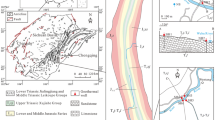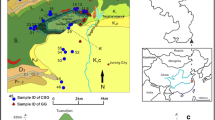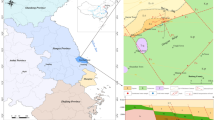Abstract
Thermal water is an important natural resource. The hydrogeochemistry and geothermometry of thermal water from the Qianyi well (TWQW), which is associated with the Tongjing Warm Springs located in the Eastern Sichuan Fold Belts in Chongqing, SW China, was investigated. The reservoir of this region consists of upper and middle Triassic carbonate and evaporite rocks. The TWQW was of Ca–Mg–SO4 type with water temperature of 47.3 °C. Plotting on the Giggenbach Na–K–Mg diagram indicates that the TWQW was immature due to a mixing of shallow karst groundwater and thermal water. The mixing model indicates that the TWQW was composed of 49% deep thermal water and 51% shallow karst groundwater. Geothermometers suggest a reservoir temperature of about 79 °C, locating this aquifer at a depth of ~ 2.5 km. The δD and δ18O values plot near the local meteoric water line, suggesting that the TWQW originates from local meteoric water at recharge elevations of ~ 780–1160 m a.s.l.. A conceptual model of the genesis for Tongjing Warm Springs was developed. Rainfall infiltrates via karst outcrops in the elevated areas of the northern Tongluoxia anticline, extracts heat from reservoir rocks at depth, dissolves minerals and becomes thermal water. The thermal water is driven by gravity, flows through the carbonate–evaporite aquifer, and follows the Tongluoxia anticline of the Eastern Sichuan Fold Belts to the southwest. The thermal water ascends to the surface along the incision created by the Wentang River and mixes with shallow karst groundwater to create warm springs. This study may be relevant to other karst geothermal reservoirs in China.





(modified from Majumdar et al. 2009). Due to stabilization, all physical and chemical data overlap in the plot



Similar content being viewed by others
References
Allums SE, Opsahl SP, Golladay SW, Hicks DW, Conner LM (2012) Nitrate concentrations in springs flowing into the lower Flint River Basin, Georgia USA. J Am Water Resour Assoc 48:423–438. https://doi.org/10.1111/j.1752-1688.2011.00624.x
Audra P, D’Antoni-Nobecourt JC, Bigot JY (2010) Hypogenic caves in France. Speleogenesis and morphology of the cave systems. Bull Soc Geol Fr 181:327–335
Chandrajith R, Barth JAC, Subasinghe ND, Merten D, Dissanayake CB (2013) Geochemical and isotope characterization of geothermal spring waters in Sri Lanka: evidence for steeper than expected geothermal gradients. J Hydrol 476:360–369. https://doi.org/10.1016/j.jhydrol.2012.11.004
Cheng Q, Yang H, Zeng M (2015) The formation and protection of karst geothermal water resources in the main urban area of Chongqing. Carsologica Sinica 34:217–227. https://doi.org/10.11932/karst20150303 (in Chinese with English abstract)
Chongqing Municipal People’s Government (2010) Geoglogical survey report of Chongqing, the capital of Warm Spring in China. Chongqing Municipal People’s Government, Chongqing (in Chinese without English abstract)
Cinti D, Procesi M, Tassi F, Montegrossi G, Sciarra A, Vaselli O, Quattrocchi F (2011) Fluid geochemistry and geothermometry in the western sector of the Sabatini volcanic district and the Tolfa mountains (Central Italy). Chem Geol 284:160–181. https://doi.org/10.1016/j.chemgeo.2011.02.017
Craig H (1961) Isotopic variations in meteoric waters. Science 133:1702–1703
Cruz JV, França Z (2006) Hydrogeochemistry of thermal and mineral water springs of the Azores archipelago (Portugal). J Volcanol Geotherm Res 151:382–398. https://doi.org/10.1016/j.jvolgeores.2005.09.001
D’Amore F, Ramos-Candelaria MN, Seastres J Jr, Ruaya JR, Nuti S (1993) Applications of gas chemistry in evaluating physical processes in the Southern Negros (Palinpinon) geothermal field, Philippines. Geothermics 22:535–553. https://doi.org/10.1016/0375-6505(93)90035-L
Dansgaard W (1964) Stable isotopes in precipitation. Tellus 16:436–468. https://doi.org/10.1111/j.2153-3490.1964.tb00181.x
Ford DC, Williams PW (2007) Karst hydrogeology and geomorphology. Wiley Press, Chichester
Fouillac C, Michard G (1981) Sodium/lithium ratios in water applied to geothermometry of geothermal reservoirs. Geothermics 10:55–70. https://doi.org/10.1016/0375-6505(81)90025-0
Fournier RO (1977) Chemical geothermometers and mixing models for geothermal systems. Geothermics 5:41–50. https://doi.org/10.1016/0375-6505(77)90007-4
Fournier RO, Truesdell AH (1973) An empirical Na–K–Ca geothermometer for natural waters. Geochim Cosmochim Acta 37:1255–1275. https://doi.org/10.1016/0016-7037(73)90060-4
Fournier RO, Truesdell AH (1974) Geochemical indicators of subsurface temperature—2. Estimation of temperature and fraction of hot water mixed with cold water. J Res US Geol Surv 2:263–270. https://doi.org/10.3133/ofr741032
Giggenbach WF (1988) Geothermal solute equilibria. Derivation of Na–K–Mg–Ca geoindicators. Geochim Cosmochim Acta 52:2749–2765. https://doi.org/10.1016/0016-7037(88)90143-3
Goldscheider N, Mádl-Szőnyi J, Erőss A, Schill E (2010) Review: thermal water resources in carbonate rock aquifers. Hydrogeol J 18(6):1303–1318. https://doi.org/10.1007/s10040-010-0611-3
Gunn J, Bottrell SH, Lowe DJ, Worthington SRH (2006) Deep groundwater flow and geochemical processes in limestone aquifers: evidence from thermal waters in Derbyshire, England, UK. Hydrogeol J, 14: 868–881. https://doi.org/10.1007/s10040-006-0022-7
Guo Q, Wang Y (2012) Geochemistry of hot springs in the Tengchong hydrothermal areas, Southwestern China. J Volcanol Geotherm Res 215–216:61–73. https://doi.org/10.1016/j.jvolgeores.2011.12.003
Hudspith VA, Belcher CM, Kelly R, Hu FS (2015) Charcoal reflectance reveals early holocene boreal deciduous forests burned at high intensities. PLoS One 10:e0120835. https://doi.org/10.1371/journal.pone.0120835
Ibrahim C (2002) A new improved Na/K geothermometer by artificial neural networks. Geothermics 31:751–760. https://doi.org/10.1016/S0375-6505(02)00044-5
Jiang XW, Wan L, Ge S, Cao GL, Hou GC, Hu FS, Wang XS, Li HL, Liang SH (2012) A quantitative study on accumulation of age mass around stagnation points in nested flow systems. Water Resour Res 48:771–784. https://doi.org/10.1029/2012wr012509
Jin L, Siegel DI, Lautz LK, Mitchell MJ, Dahms DE, Mayer B (2010) Calcite precipitation driven by the common ion effect during groundwater-surface-water mixing: a potentially common process in streams with geologic settings containing gypsum. Geol Soc Am Bull 122:1027–1038. https://doi.org/10.1130/B30011.1
Kong Y, Pang Z, Shao H, Hu S, Kolditz O (2014) Recent studies on hydrothermal systems in China: a review. Geotherm Energy. https://doi.org/10.1186/s40517-014-0019-8
Kutzbach JE (1981) Monsoon climate of the early Holocene: climate experiment with the Earth’s orbital parameters for 9000 years ago. Science 214:59–61. https://doi.org/10.1126/science.214.4516.59
Lee S, Kim T, Lee TJ (2011) Strontium isotope geochemistry and its geochemical implication from hot spring waters in South Korea. J Volcanol Geotherm Res 208:12–22. https://doi.org/10.1016/j.jvolgeores.2011.09.004
Li D, Liu D (2011) Geothermal reservoir structure and runoff flow recharge of geothermal water resources in Chongqing City. J Hohai Univ (Nat Sci) 39:372–376. https://doi.org/10.3876/j.issn.1000-1980.2011.04.004 (in Chinese with English abstract)
Li T, Li H, Shen C, Yang C, Li J, Yi C, Yuan D, Wang J, Xie S (2010) Study on the δD and δ18O characteristics of meteoric precipitation during 2006–2008 in Chongqing. Adv Water Sci 21:757–764 (in Chinese with English abstract)
Lu L, Pang Z, Kong Y, Guo Q, Wang Y, Xu C, Gu W, Zhou L, Yu D (2018) Geochemical and isotopic evidence on the recharge and circulation of geothermal water in the Tangshan geothermal system near Nanjing, China: implications for sustainable development. Hydrogeol J 26:1705–1719. https://doi.org/10.1007/s10040-018-1721-6
Lund JW, Freeston DH, Boyd TL (2011) Direct utilization of geothermal energy 2010 worldwide review. Geothermics 40:159–180. https://doi.org/10.1016/j.geothermics.2011.07.004
Luo X (2000) Formation and characteristics of the geothermal spring in Tongjing scenic spot, North Chongqing district, Chongqing City. Carsologica Sinica 19:159–163 (in Chinese with English abstract)
Luo Y, Liu D, Liu X (2006a) System of the geothermal water in the Nanwenquan anticline. J Chongqing Univ (Nat Sci Ed) 29:131–158 (in Chinese with English abstract)
Luo Y, Liu D, Xu M (2006b) Study on the geothermal water runoff in Chongqing. Earth Environ 34:49–54 (in Chinese with English abstract)
Ma R, Wang YX, Sun ZY, Zheng CM, Ma T, Prommer H (2011) Geochemical evolution of groundwater in carbonate aquifers in Taiyuan, northern China. Appl Geochem 26:884–897. https://doi.org/10.1016/j.apgeochem.2011.02.008
Mádl-Szőnyi J, Simon S (2016) Involvement of preliminary regional fluid pressure evaluation into the reconnaissance geothermal-exploration—example of an overpressured and gravity-driven basin. Geothermics 60:156–174. https://doi.org/10.1016/j.geothermics.2015.11.001
Mádl-Szőnyi J, Tóth A (2015) Basin-scale conceptual groundwater flow model for an unconfined and confined thick carbonate region. Hydrogeol J 23:1359–1380. https://doi.org/10.1007/s10040-015-1274-x
Majumdar N, Mukherjee AL, Majumdar RK (2009) Mixing hydrology and chemical equilibria in Bakreswar geothermal area, eastern India. J Volcanol Geotherm Res 183:201–212. https://doi.org/10.1016/j.jvolgeores.2009.03.014
Mao X, Wang Y, Zhan H, Feng L (2015) Geochemical and isotopic characteristics of geothermal springs hosted by deep-seated faults in Dongguan Basin, Southern China. J Geochem Explor 158:112–121. https://doi.org/10.1016/j.gexplo.2015.07.008
Millot R, Négrel P (2007) Multi-isotopic tracing (δ7Li, δ11B, 87Sr/86Sr) and chemical geothermometry: evidence from hydro-geothermal systems in France. Chem Geol 244: 664–678. https://doi.org/10.1016/j.chemgeo.2007.07.015
Moreira P, Fernández RR (2015) La Josefina Au–Ag deposit (Patagonia, Argentina): a Jurassic epithermal deposit formed in a hot spring environment. Ore Geol Rev 67:297–313. https://doi.org/10.1016/j.oregeorev.2014.12.012
Opazo T, Aravena R, Parker B (2016) Nitrate distribution and potential attenuation mechanisms of a municipal water supply bedrock aquifer. Appl Geochem 73:157–168. https://doi.org/10.1016/j.apgeochem.2016.08.010
Pang Z, Kong Y, Shao H, Kolditz O (2018) Progress and perspectives of geothermal energy studies in China: from shallow to deep systems. Environ Earth Sci 77:580. https://doi.org/10.1007/s12665-018-7757-z
Pastorelli S, Marini L, Hunziker JC (1999) Water chemistry and isotope composition of the Acquarossa thermal system. Ticino Switz Geotherm 28:75–93. https://doi.org/10.1016/S0375-6505(98)00045-5
Pirlo MC (2004) Hydrogeochemistry and geothermometry of thermal groundwaters from the Birdsville Track Ridge, Great Artesian Basin, South Australia. Geothermics 33:743–774. https://doi.org/10.1016/j.geothermics.2004.07.001
Pu JB, Yuan DX, Zhang C, Zhao HP (2012) Identifying the sources of solutes in karst groundwater in Chongqing, China: a combined sulfate and strontium isotope approach. Acta Geol Sinica 86:980–992. https://doi.org/10.1111/j.1755-6724.2012.00722.x
State Bureau of Technical Supervision of China (1995) Method for examination of drinking natural mineral water (GB/T 8538 – 1995). State Bureau of Technical Supervision of China, Beijing (in Chinese without English abstract)
Stober I, Zhong J, Zhang L, Bucher K (2016) Deep hydrothermal fluid-rock interaction: the thermal springs of Da Qaidam, China. Geofluids 16:711–728. https://doi.org/10.1111/gfl.12190
Tassi F, Aguilera F, Darrah T, Vaselli O, Capaccioni B, Poreda RJ, Delgado Huertas A (2010) Fluid geochemistry of hydrothermal systems in the Arica-Parinacota, Tarapacá and Antofagasta regions (northern Chile). J Volcanol Geotherm Res 192:1–15. https://doi.org/10.1016/j.jvolgeores.2010.02.006
Timsic S, Patterson WP (2014) Spatial variability in stable isotope values of surface waters of eastern Canada and New England. J Hydrol 511:594–604. https://doi.org/10.1016/j.jhydrol.2014.02.017
Tóth J (1963) A theoretical analysis of groundwater flow in small drainage basins. J Geophys Res 68:4795–4812. https://doi.org/10.1029/Jz068i008p02354
Umezawa Y, Hosono T, Onodera S, Siringan F, Buapeng S, Delinom R, Yoshimizu C, Tayasu I, Nagata T, Taniguchi M (2008) Sources of nitrate and ammonium contamination in groundwater under developing Asian megacities. Sci Total Environ 404:361–376. https://doi.org/10.1016/j.scitotenv.2008.04.021
Verma SP, Santoyo E (1997) New improved equations for Na/K, Na/Li and SiO2, geothermometers by outlier detection and rejection. J Volcanol Geotherm Res 79:9–23. https://doi.org/10.1016/S0377-0273(97)00024-3
Vesper DJ, White WB (2004) Storm pulse chemographs of saturation index and carbon dioxide pressure: implications for shifting recharge sources during storm events in the karst aquifer at Fort Campbell, Kentucky/Tennessee, USA. Hydrogeol J 12:135–143. https://doi.org/10.1007/s10040-003-0299-8
Wang J, Huang SY, Huang GS, Wang JY (1990) Basic characteristics of the Earth’s temperature distribution in China. Seismological Press, Beijing
Wang G, Li K, Wen D, Lin W, Lin L, Liu Z, Zhang W, Ma F, Wang W (2013) Assessment of geothermal resources in China, In: Proceedings, thirty-eighth workshop on geothermal reservoir engineering, Stanford University, Stanford, California, February 11–13
Wang JL, Jin MG, Jia BJ, Kang FX (2015) Hydrochemical characteristics and geothermometry applications of thermal groundwater in northern Jinan, Shandong China Geothermics 57:185–195. https://doi.org/10.1016/j.geothermics.2015.07.002
Xiao Q, Jiang YJ, Shen LC, Yuan DX (2018) Origin of calcium sulfate-type water in the Triassic carbonate thermal water system in Chongqing, China: a chemical and isotopic reconnaissance. Appl Geochem 89:49–58. https://doi.org/10.1016/j.apgeochem.2017.11.011
Yang P, Yuan D, Ye X, Xie S, Chen X, Liu Z (2013) Sources and migration path of chemical compositions in a karst groundwater system during rainfall events. Chin Sci Bull 58: 2488–2496. https://doi.org/10.1007/s11434-013-5762-x
Yang P, Cheng Q, Xie S, Wang J, Chang L, Yu Q, Zhan Z, Chen F (2017) Hydrogeochemistry and geothermometry of deep thermal water in the carbonate formation in the main urban area of Chongqing, China. J Hydrol 549:50–61. https://doi.org/10.1016/j.jhydrol.2017.03.054
Yao T, Thmpson LG, Mosley-Thompson E, Yang Z (1996) Climatological significance of δ18O in north Tibetan ice cores. J Geophys Res Atmos 101:29531–29537. https://doi.org/10.1029/96JD02683
Zeng M (2012) Distribution and genesis of Chongqing hot spring. Master Thesis, Chengdu University of Technology (In Chinese with English abstract)
Zheng K, Han Z, Zhang Z (2010) Steady industrialized development of geothermal energy in China, In: Proceedings of the 2010 world geothermal congress, Bali, Indonesia, pp 25–29
Zhou X, Jin X, Liang S, Shen Y, Zhang H (2010) Monograph of groundwater sciences. Geological Publishing House, Beijing (in Chinese without English abstraction)
Acknowledgements
We thank Brian Ham (Tennessee Department of Environment and Conservation, Division of Water Resources) for his constructive comments. This work was supported by the Fundamental Research Funds for the Central Universities (XDJK2018AB002), and the China Scholarship Council (CSC).
Author information
Authors and Affiliations
Corresponding author
Additional information
Publisher’s Note
Springer Nature remains neutral with regard to jurisdictional claims in published maps and institutional affiliations.
Rights and permissions
About this article
Cite this article
Yang, P., Dan, L., Groves, C. et al. Geochemistry and genesis of geothermal well water from a carbonate–evaporite aquifer in Chongqing, SW China. Environ Earth Sci 78, 33 (2019). https://doi.org/10.1007/s12665-018-8004-3
Received:
Accepted:
Published:
DOI: https://doi.org/10.1007/s12665-018-8004-3




